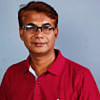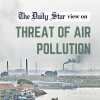Brick kilns top polluter

Brick kilns are the top air polluter in seven major cities in the country, particularly during dry season when most bricks are made, turning the air quality of these metropolises “severely unhealthy”.
Also to blame are construction work that kicks up dust, poorly-maintained vehicles that emit excessive harmful particles and toxic gases, and industrial air pollution, according to the Department of Environment (DoE).
A five-year survey by the department found Narayanganj has the most polluted air, followed by Dhaka. Third is Gazipur, which is followed by Rajshahi, Chattogram, Khulna, and Barisal. The air in Sylhet city, however, is cleaner.
The survey was done between 2013 and 2018 with funds from the World Bank.
Even though Dhaka came out second worst in the country, the World Health Organisation (WHO) in 2018 said Dhaka was the world's third worst city in terms of air pollution, behind Delhi and Cairo.
Continued exposure to poor quality air can cause heart diseases, lung cancer, chronic obstructive pulmonary diseases, and respiratory infections, including pneumonia. It could also cause stroke, according to the WHO.
The UN health body estimates 37,000 Bangladeshis die due to air pollution every year, the average age of the victims being just 38 years.
BRICK KILNS TOP CULPRIT
The study found air quality of these cities plummets between November and April when brick kilns operate and when there are a lot of particles in the air.
The DoE installed equipment at 11 places in the eight cities to collect daily data to prepare the Air Quality Index (AQI), which gave a score between zero and 500, zero being the best.
The equipment collected various data, including airborne particles, Sulfur Dioxide, Carbon Monoxide, and Nitrogen Oxides, all of which are harmful for health.
The AQI of 0-50 was categorised as good, 51-100 as moderate, 101-150 cautionary, 151-200 unhealthy, 201-300 very unhealthy, and 301-500 severely unhealthy.
In 2018, Narayanganj had 105 days with its AQI over 301 (severely unhealthy). Dhaka had such air on 83 days, Gazipur 72 days, Rajshahi 45 days, Khulna 39 days, Chattogram 13 days, Barisal 9 days, and Sylhet 8 days, the survey report said.
On January 20 this year, Narayanganj scored 475, Gazipur 400, Dhaka 382, Chittagong 361, Rajshahi 356, and Barisal 335.
Ziaul Haque, DoE director for air quality management, said that in 2017-18 fiscal year, half the air pollution in Dhaka was caused by brick kilns while construction work contributed around 25 percent and vehicle emission 10-12 percent.
The case is roughly the same in other cities, he added.
There are 7,707 brick kilns in the country, including 366 in Barisal division, 1,529 in Chattogram, 256 in Sylhet, 2,295 in Dhaka, 873 in Khulna and 1,176 in Rajshahi division, according to the latest DoE data.
DoE permission is mandatory for brick kilns. But 2015 data show at least 1,957 of them did not have it. There were 6,895 brick kilns in the country at the time.
Ziaul claimed that they were taking measures to stop the rapid sprouting and growth of brick kilns in the country.
“If we can use alternatives to bricks or use modern technology to manufacture bricks, the pollution level would fall,” he said, adding that they were working to formulate a revised code to phase out kilns that use age-old methods to bake the bricks.
The government is now promoting modern technology for brick kilns like Hybrid Hoffrman and Tunnel technology.
Hybrid Hoffman Kiln (HHK) technology was developed and is widely used in China. The HHK combines use of green bricks produced by mixing powdered fuel with clay; and utilisation of waste heat by transferring the heat to an adjacent tunnel.
Tunnel kiln is a continuous moving ware kiln in which the clay products to be fired are passed on cars through a long horizontal tunnel. The firing of products occurs at the central part of the tunnel. The tunnel kiln is considered to be the most advanced brick making technology. The main advantages of tunnel kiln technology lie in its ability to fire a wide variety of clay products.
Making bricks using these methods requires less coal or wood, hence less pollution.
For example, a conventional brick kiln requires 20 tonnes of coal to make 1,00,000 bricks, way more than 13-14 tonnes needed to make equal number of bricks using modern technology.
HEALTH IMPACT
According to a World Health Organisation (WHO) report released in May last year, around 7 million people die globally every year from exposure to fine particles in polluted air that penetrate deep into the lungs and cardiovascular system. It causes diseases including stroke, heart disease, lung cancer, chronic obstructive pulmonary diseases and respiratory infections, including pneumonia.
Outdoor air pollution alone caused some 4.2 million deaths in 2016 while air pollution indoors, from cooking with polluting fuels and technologies, caused an estimated 3.8 million deaths during the same period.
More than 90 percent of the deaths were in low- and middle-income countries, mainly in Asia and Africa, said the WHO report.
“The WHO recognised that air pollution is a critical risk factor for non-communicable diseases, causing an estimated one-quarter (24 percent) of all adult deaths from heart disease, 25 percent from stroke, 43 percent from chronic obstructive pulmonary diseases, and 29 percent from lung cancer,” it read.
Md Kamruzzaman, assistant professor of department respiratory medicine at Dhaka Shishu Hospital, said the number of patients of asthma, bronchiolitis, respiratory tract infections, and common cold increases during dry season.
He said children with asthma or allergy issues were the main victims of dust particles in the air.
On average, the hospital treats about 100 outdoor patients every day. Most of them come with respiratory problems, he said.
Fatematuz Zohura, a fourth grader at a school in Savar, was taken to Shishu Hospital on January 16 following a severe asthma attack. She had to stay in the National Institute of Diseases of the Chest and Hospital (NIDCH) for three days in August last year as well.
Masud Rana, of Nabisco area in Dhaka, has also been struggling with asthma for a month.
“We recommend these patients to avoid dust and use mask as it is not a curable disease,” Kamruzzaman said.
Dewan Azmal Hossain, assistant professor of respiratory medicine at NIDCH, said exposure to dust and other particles in the air could cause sinusitis and lead to severe asthma attacks. Chronic exposure to dust could turn into a serious case of tuberculosis, he said.
They get almost double the patients with respiratory problems during the dry season, he added.
Dhaka South City Corporation Mayor Sayeed Khokon said they started a programme late last month to spray water on streets to reduce dust.

 For all latest news, follow The Daily Star's Google News channel.
For all latest news, follow The Daily Star's Google News channel. 








Comments